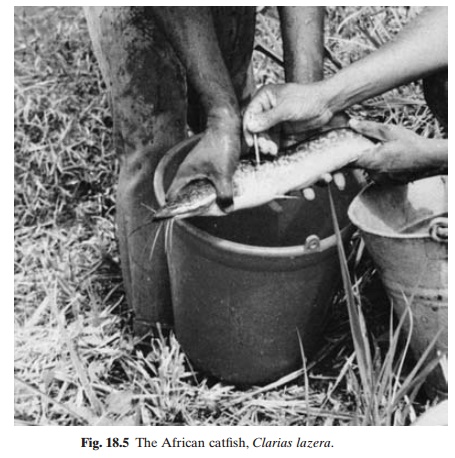Chapter: Aquaculture Principles and Practices: Catfishes
Spawning and fry production of African catfish
Spawning and fry production
Clarias lazera are reported to become matureunder natural conditions at the size of about 32cm (two or three years old) and spawn in the flooded rivers. Under pond conditions they mature in about seven months, when they have attained a weight of 200–300g. The spawning season varies between regions. In Egypt and Central Africa it is between July and September and in West Africa in April and May. They seem to spawn only once with the onset of the rainy season, under natural conditions, but can be bred throughout the year in captivity.
Observations confirm that spawning is stimulated by floods or increased levels of water in ponds due to rain or exchange with fresh water, as in the case of C. batrachus. Eggs are ejected in several batches (15–50 batches) during the extended mating and spawning, at temperatures above 17°C.The eggs adhere to sedges and grass.

While it is fairly easy to spawn mature fish in ponds by simulating changes in water levels, as happens during floods in nature (by draining the ponds partly and filling them suddenly with fresh water), the survival of offspring is generally very poor. Unlike some of the other catfish, C. lazera does not seem to show any parentalcare, and under pond conditions the larvae and fry seem to become cannibalistic. Additionally, there is a fair amount of predation by frogs and other aquatic animals in ponds. Because of these limitations, methods of induced spawning are adopted for the production of fry.
For induced spawning, brood stock from natural habitats or culture ponds can be used. Ripe females in captivity range in size from 28–65cm, weighing 175–1600g. Females can be identified by the rounded vent with a longitudinal cleft, and the males by the elongated urogenital papilla. From experimental studies it is concluded that the best means of stimulating ovulation in females is by injection of the hormone product desoxycorticosterone (DOCA). The suggested dose is a single intraperitoneal injection of 5mg DOCA per 100g weight of fish. Injected females and mature males (which may not require any injection) are kept in separate tanks for about 10 hours, after which they are placed together in a tank or cement cistern, usually in the evening. Spawning occurs during the night, about 10–16 hours after injection of the female. The eggs can easily be collected in the morning and hatched in separate containers. The main problem with this method is that the couples often inflict fatal injuries on each other. To avoid this, the injected females can be stripped and the eggs fertilized artificially. First the females are injected with the above dose of DOCA, usually in the morning, and the males in the evening. The female is stripped about 10 hours after the injection. Males cannot be hand stripped because of the structural peculiarities of the seminal vesicle. If pressure is exerted on the abdomen, the milt will pass to the dorso-lateral lobes of the vesicle and not to the genital opening. So the males have to be killed and the sperm collected directly from the vesicles. Injection helps to increase the yield of milt three to five times. Embryonic development is completed in about 24 hours after fertilization at temperatures around 26°C. The yolk sac is absorbed in six days and the larvae start feeding when about three days old.
Clarias lazera can be spawned by hypophy-sation as well, like many other species (Hogendoorn, 1979). Acetonedried carp pituitary at a dose of 4mg per kg body weight is adequate to ripen females. As mentioned earlier, injection of males does not seem to help in stripping them, and they have to be sacrificed to obtain milt. The females can be stripped 11–16 hours after injection. At 20°C, hatching of fertilized eggs occurs in about 48 hours, when the hatchlings can be transferred from incubators to a trough for rearing.
The stocking rate of fry is generally 10000– 20000 per ha. Fed on natural food, they reach a weight of around 10g in about three weeks. Thereafter, the fry start feeding on larvae of aquatic insects. Artificial feeds can be given to the fry at this stage.Though amphibians, aquatic insects and occasionally wild fish prey on the fry, the main reason for low survival in ponds appears to be the lack of appropriate feed.
Related Topics